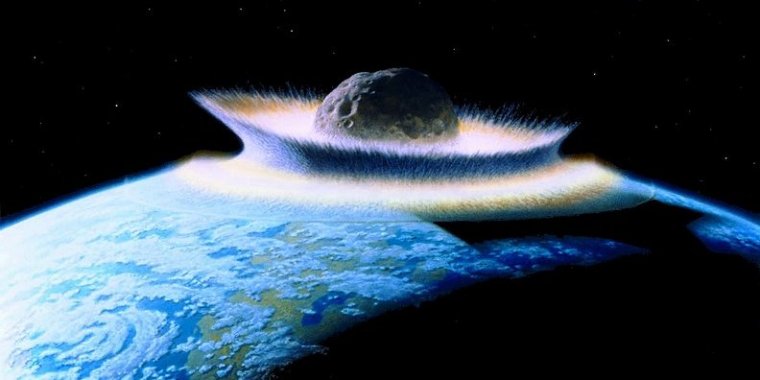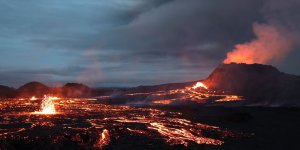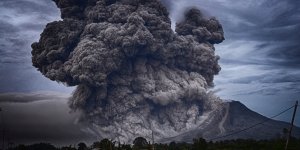| News / World News |
Dinosaur-Killing Asteroid Also Triggered A Global Tsunami
The dinosaur-killing asteroid that slammed into Earth 66 million years ago also triggered a jumbo-size tsunami with mile-high waves in the Gulf of Mexico whose waters traveled halfway around the world, a new study found.

Dinosaur-Killing Asteroid Also Triggered A Global Tsunami. Photo: Don Davis/Wikimedia Commons
Researchers discovered evidence of this monumental tsunami after analyzing cores from more than 100 sites worldwide and creating digital models of the monstrous waves after the asteroid's impact in Mexico's Yucatán Peninsula.
"This tsunami was strong enough to disturb and erode sediments in ocean basins halfway around the globe," study lead author Molly Range, who conducted the modeling study for a master's thesis in the Department of Earth and Environmental Sciences at the University of Michigan, said in a statement.
Range dove into the tsunami's journey immediately following the asteroid's collision. Based on earlier findings, her team modeled an asteroid that measured 8.7 miles (14 kilometers) across and was zooming 27,000 mph (43,500 km/h), or 35 times the speed of sound when it struck Earth.
After the asteroid hit, many lifeforms died; the nonavian dinosaurs went extinct (only birds, which are living dinosaurs, survive today) and about three-quarters of all plants and animal species were wiped out.
Researchers are aware of many of the asteroid's pernicious effects, such as sparking raging fires that cooked animals alive and pulverizing sulfur-rich rocks that led to lethal acid rain and extended global cooling.
To learn more about the resulting tsunami, Range and her colleagues analyzed the Earth's geology, successfully analyzing 120 "boundary sections," or marine sediments laid down just before or after the mass extinction event, which marked the end of the Cretaceous period.
These boundary sections matched the predictions of their model of wave height and travel, Range said.
The initial energy from the impact tsunami was up to 30,000 times larger than the energy released by the December 2004 Indian Ocean earthquake tsunami that killed more than 230,000 people, the researchers found.
Once the asteroid struck Earth, it created a 62-mile-wide (100 km) crater and kicked up a dense cloud of dust and soot into the atmosphere.
Just 2.5 minutes after the strike, a curtain of ejected material pushed a wall of water outward, briefly making a 2.8-mile-tall (4.5 km) wave that crashed down as the ejecta plummeted back to Earth, according to the simulation.
At the 10 minute mark, a 0.93-mile-high (1.5 km) tsunami wave about 137 miles (220 km) away from the impact site swept through the gulf in all directions.
An hour after the impact, the tsunami had left the Gulf of Mexico and rushed into the North Atlantic. Four hours following the impact, the tsunami passed through the Central American Seaway — a passage that separated North from South America at the time — and into the Pacific.
A full day after the asteroid's collision, the waves had traveled through most of the Pacific and the Atlantic, entering the Indian Ocean from both sides, and touching most of the globe's coastlines 48 hours after the strike.
After the impact, the tsunami radiated mostly to the east and northeast, gushing into the North Atlantic Ocean, as well as to the southwest via the Central American Seaway flowing into the South Pacific Ocean.
Water traveled so quickly in these areas that it likely exceeded 0.4 mph (0.6 km/h), a velocity that can erode the seafloor's fine-grained sediments.
Other regions largely escaped the tsunami's power, including the South Atlantic, the North Pacific, the Indian Ocean and what is now the Mediterranean sea, according to the team's models. Their simulations showed that the water speeds in these areas were less than the 0.4 mph threshold.
The team even found outcrops — or exposed rocky deposits — from the impact event on eastern New Zealand's north and south islands, a distance of more than 7,500 miles (12,000 km) from the Chicxulub crater in Mexico.
Originally, scientists thought that these outcrops were from local tectonic activity. But due to their age and location in the tsunami's modeled route, the study's researchers pinned it to the asteroid's massive waves.
"We feel these deposits are recording the effects of the impact tsunami, and this is perhaps the most telling confirmation of the global significance of this event," Range said.
While the models didn't assess coastal flooding, they did reveal that open-ocean waves in the Gulf of Mexico would have exceeded 328 feet (100 m), and waves would have reached heights of more than 32.8 feet (10 m) as the tsunami approached the North Atlantic's coastal regions and parts of South America's Pacific coast, according to the statement.
As the water became shallow near the coast, wave heights would have risen dramatically.
"Depending on the geometries of the coast and the advancing waves, most coastal regions would be inundated and eroded to some extent," the authors wrote in the study.
"Any historically documented tsunamis pale in comparison with such global impact." (Tasnim News Agency)
YOU MAY ALSO LIKE





